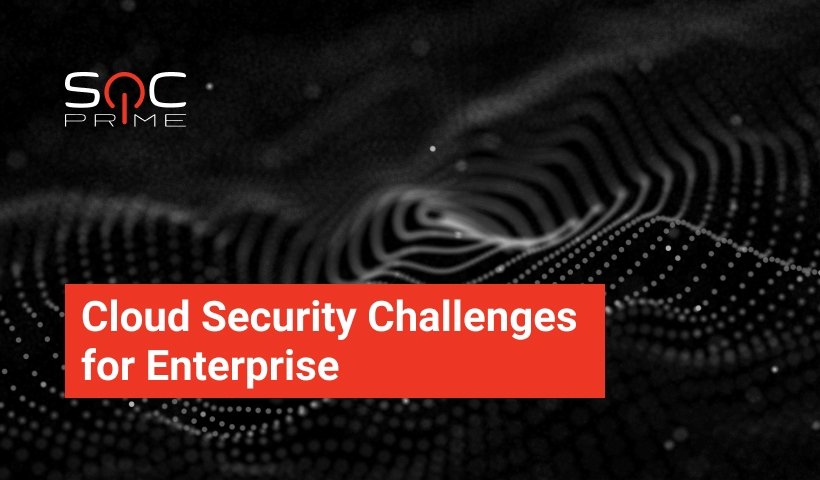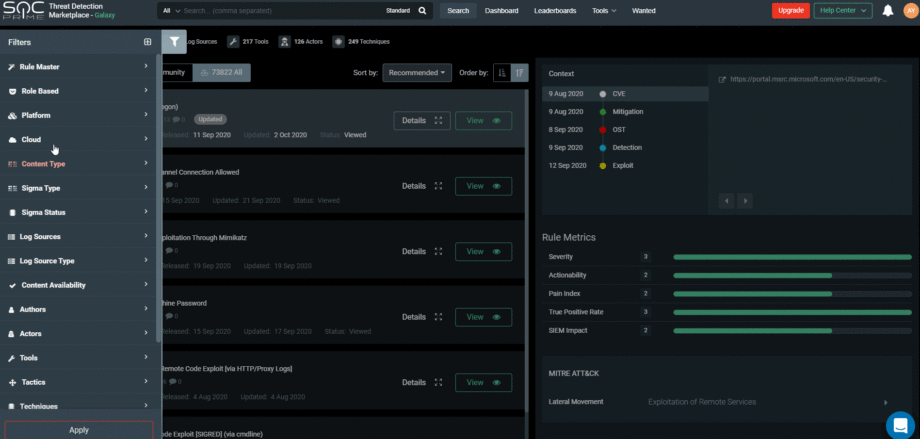Cloud Security Challenges for Enterprise

Table of contents:
Cloud services are an irreplaceable part of modern enterprise infrastructure, over 70% of the world’s organizations fully or partially operate on the cloud as reported by Cloud Security Alliance. Cloud service providers also provide extra security measures, such as automated threat detection. But according to statistics, up to 90% of all cybersecurity professionals are now concerned about cloud security issues, which is 11% more compared to 2019 data from the Cloud Security Spotlight report. At the same time, the 2019 Cyber Security Report shows that 28% of all organizations experienced cloud-related security incidents in the past year. The core reason for most of them is the lack of visibility across a company’s entire network and the cloud. Insufficient cybersecurity competencies in employees is another common reason why companies fail to effectively manage cloud solutions. SOC Prime believes that recognizing the challenges enterprises face towards cloud security helps to create the right strategy and minimize risks related to the cloud.
Cloud Security Challenges
Data Security and Privacy are the most important and critical factors and needed to be addressed first. Other cybersecurity challenges related to the Data Security:
- Incident Response arrangements
- Application Security
- Availability of services and data in the Cloud
- Ability to support BCP and DR Requirements
- Data leak Prevention in the Cloud
- Identity and Access Management
- Threat and Vulnerability Management
- Data Segregation and Protection
Data Segregation and Protection, and Data Leak Prevention are considered to be the most important and critical questions due to their significance to the entire business. Data leaks may damage the company’s reputation with partners and customers and heavily impact brand perception. Loss of intellectual property is another unwanted consequence that may lead to an even bigger market value loss.
Need for an Effective Migration Strategy
It has already become a common practice for organizations to migrate parts of their infrastructure to clouds. Not all migrations can be performed free of modification, and effective security arrangement is one of the most vital stages during this transition. While inadequate strategy may lead to infrastructure exposed to a variety of threats, the question of shared security responsibility between CSPs and enterprises leveraging the cloud becomes even more crucial.
Another challenge a migration causes is aligning employees’ skills with the demands of new architecture and upgrading legacy systems. Professional skills should be enhanced since the lack of specific knowledge results in additional security risks. What is more, upgrading outdated software is an inevitable part of cloud migration, and there are a number of risks related to this process. Besides, running outdated software often becomes a challenge for the implementation of effective security, and leaves space for attackers’ exploitation.
Cloud Visibility
Limited infrastructure visibility is the second most common problem associated with cloud security. Insufficient cloud usage visibility takes place when an enterprise doesn’t have the ability to visualize and analyze cloud utilization safety and security. The issues mainly originate from employees using unsanctioned apps or misusing sanctioned apps.
In the case of unsanctioned apps, employees use cloud applications and resources without permission and support of the SOC department. Being a violation of corporate policies, such shadow IT activities pose risks to sensitive corporate data.
As for sanctioned app misuse, enterprises are often unable to analyze how their approved applications are being leveraged by employees. This leaves space for excessive staff activities as well as overshadows hackers’ exploitation, DNS attacks, or SQL injections.
Cloud-Specific Security Weak Points
Ensuring the infrastructure protection for DDoS attacks is another crucial matter for a cloud that aims at ensuring steady-flow operation of servers and conclusively prevents revenue losses and brand damage. With DDoS attacks being an inevitable part of attacks aimed at stealing or damaging sensitive data, it is vital for companies to ensure an effective disaster recovery process and adopt actionable protection for all network layers.
A malware injection attack is one of the major security challenges. Operating on the servers of the CSP, the injected malicious code is viewed solely as a part of the cloud service and its software. As a result, attackers can eavesdrop, compromise the integrity of sensitive information, and steal data.
The goal of the Malware injection attack is stealing the data or eavesdropping. SQL injection attacks and cross-site scripting attacks are the most frequent forms of malware injection attacks.
Learn more about role-based Threat Detection Experience.
Actionable Cloud Security
Securing complex and dynamic cloud environments requires actionable mitigation of risks determined by cloud infrastructure specificity.
SOC Prime Threat Detection Marketplace delivers cloud-specific content to secure your cloud environment and overcome the latest and the most critical threats and affords enterprise ground to proactively defend against cyber attacks using curated content benchmarked against MITRE ATT&CK®.

Ready to try out SOC Prime Threat Detection Marketplace? Sign up for free. Or join Threat Bounty Program to craft your own content and share it with the Threat Detection Marketplace community.



